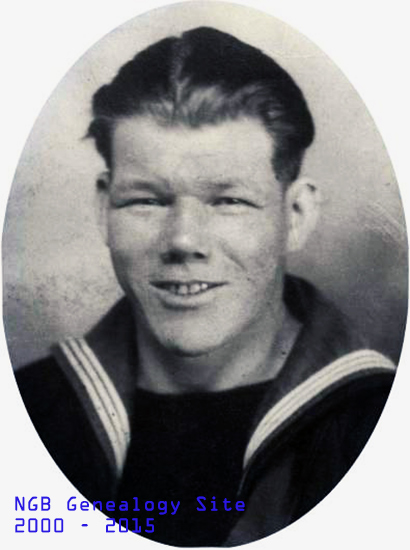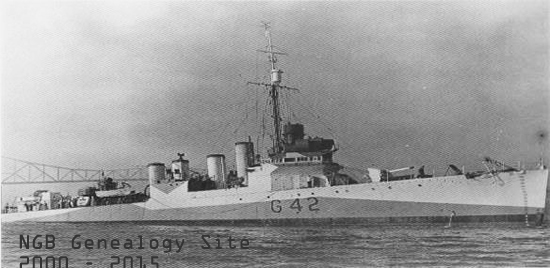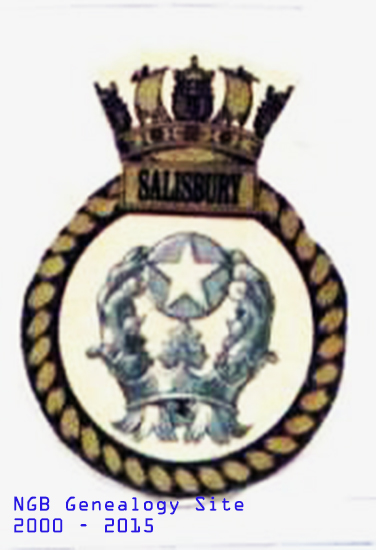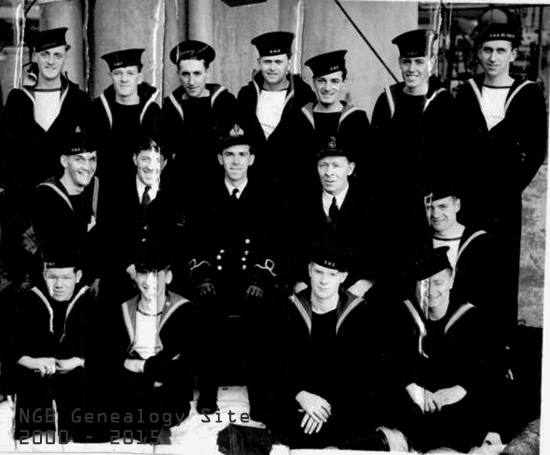Presented by the
Newfoundland's Grand Banks Site
to assist you in researching your Family History
Click on the graphic below to return to the NGB Home Page
To contribute to this site, see above menu item "About".
These transcriptions may contain human errors.
As always, confirm these, as you would any other source material.
Military Record
CHARLES E. PHILLIPS
Royal Navy
5 June 1940 to 16 Apr 1946

This is a short resume of the Military career of our beloved husband and father, Charles E Phillips b. 17 June 1915, St. John’s Nfld. d. 7 Aug 1982, Newmarket ON. Dad volunteered for Royal Navy service 14 Feb 1940 at HMS Avalon in St. John’s and commenced service 5 June 1940. His first posting was to HMS Royal Arthur, a training establishment at Skegness, (formerly a holiday Camp) in Lincolnshire on the east coast of England. He would do his joining routine and initial training here. His next posting was to HMS Drake in Devonport near Plymouth on the southeast coast of England for trades training where he trained as a Fireman. His first ship was the HMS Salisbury, which he served on from 26 Nov 1940 to 9 Dec 1943; it’s entire carer as a Royal Navy Destroyer. His next ships were HMS Asbury, HMS Elfreda and HMS Cynthia. Dad finished his sailing days on the Cynthia on 23 Feb 1945 and spent his final year in the Navy on various shore installations. He was officially released 16 April 1946.
There have in fact been 9 H.M.S. Salisbury's, the eighth was the one dad served on, and it was the former USS Claxton, weight, 1,090 tons 309 feet long 39 1/2 foot beam, armed with 1-4inch gun, 1-3 inch, 4-20MM guns and 3 torpedo tubes.

This picture is not the Salisbury but of one of the same class (Town Class Destroyers). The Salisbury was one of 50 of this class to be given to Britain in the “destroyers-for-bases exchange” program. She was decommissioned in the US Navy on 5 December 1940 and commissioned in the Royal Navy the same day as HMS Salisbury.

The HMS Salisbury arrived at Belfast, Northern Ireland 30 December 1940 for duty with the Western Approaches Command escorting Atlantic convoys. In April and May 1942, she joined in escorting USS Wasp (CV-7) on her two voyages to fly planes off for beleaguered Malta. Returning to the Clyde, Salisbury guarded troop convoys in the Atlantic until September, when she was assigned to the Royal Canadian Navy. Based in St. John's, Newfoundland, Salisbury served on local escort duty until November 1943. While serving with the RCN the Salisbury took part in the Battle of the Saint Lawrence. The Battle of the Gulf of St. Lawrence which saw German U-boats penetrate the Cabot Strait and the Strait of Belle Isle to sink 23 ships between 1942 and 1944, marked the only time since the War of 1812 that enemy warships inflicted death within Canada's inland waters. The battle advanced to within 300 kilometres of Québec City. A war that pervaded people's lives but was still somehow remote had become immediate, threatening, and very real. During late August, the commander of Germany's submarine forces, Admiral Karl Dönitz, deployed three U-boats off the Strait of Belle Isle where they could attack convoys that supported the construction of new United States Air Force facilities at Goose Bay, Labrador, or convoys that were bound from Sydney to Greenland. Thus began the tag-team blitz of Paul Hartwig's U-517 and Eberhard Hoffman's U-165, which would inflict the greatest shipping losses of the Gulf of St. Lawrence campaign.
Hartwig's submarine would end its reign of terror in the St. Lawrence on September 15 with an attack on the 21-ship convoy, SQ-36, adding the Saturnus and Inger Elisabeth to his death tally. Despite counterattacks by a heavy escort that included the Royal Navy destroyer HMS Salisbury, five other warships, and good air cover, U-517 only sustained minor damage. Before the convoy reached its destination, U-165 would send the merchantman Joannis to the bottom, too.

Above is a picture of the ship’s company (HMS Salisbury) including dad, sitting far left.
With newer escorts available, the Salisbury was placed in care and maintenance status at Halifax, and paid off on 10 December. Dad served on her until she was paid off. She was sold for scrap 26 June 1944.
Dad then spent Jan/Feb 1944 at HMS Asbury, a Fleet Air Arm station at Quonset Point, Rhode Island.
His next ships were minesweepers. All the ships that dad served on were part of the lend-lease program with the United States Navy.

H.M.S. Cynthia and H.M.S. Elfreda were both U.S. Auk Class minesweepers, which were transferred to the Royal Navy, where their class was renamed the Catherine Class Minesweepers. Both ships were built specifically for the lend-lease program and never saw service with the United States Navy nor were they christened (named) into that navy. They were built by, Associated Shipbuilding, Seattle, Washington, in 1943. H.M.S. Cynthia was built first and designated BAM-15; the H.M.S. Elfreda followed the Cynthia down the slip as BAM-16. Both ships were 221 feet in length, with a beam of 32 feet and armed with one 3-inch gun.

Dad served on the HMS Elfreda from 10 Feb 1944 to 15 Mar 1944 the H.M.S. Elfreda; dad served on is the only ship to bear that name in the Royal Navy. She was launched transferred to the Royal Navy in 1943. In 1946 she too was returned to the United States Navy and in 1947 she was once more transferred, but this time to the Turkish Navy and renamed 'Cesme'

From 26 Mar 1944 to 23 Feb 1945 he served on the HMS Cynthia. H.M.S. Cynthia was the third ship to serve in the Royal Navy with that name. The first was a sailing ship and launched in 1796, this ship served as part of Admiral Lord Nelson's fleet in Egypt in 1801. The second ship was a 340-ton destroyer launched in 1898 and served through the First World War. She was scrapped in 1920. The third ship, which Dad served onboard, was launched and transferred to the Royal navy in 1943. In 1946 she was returned to the United States Navy and sold in 1947.
Return to the Main Military Records Index
Military Records Contact: Sherwin Flight
Newfoundland's Grand Banks is a non-profit endeavor.
No part of this project may be reproduced in any form
for any purpose other than personal use.
JavaScript DHTML Menu Powered by Milonic
© Newfoundland's Grand Banks (1999-2025)
Hosted by
![]()
Your Community, Online!
![[Recent]](../../recent.gif)
![[Home]](../../home.gif)